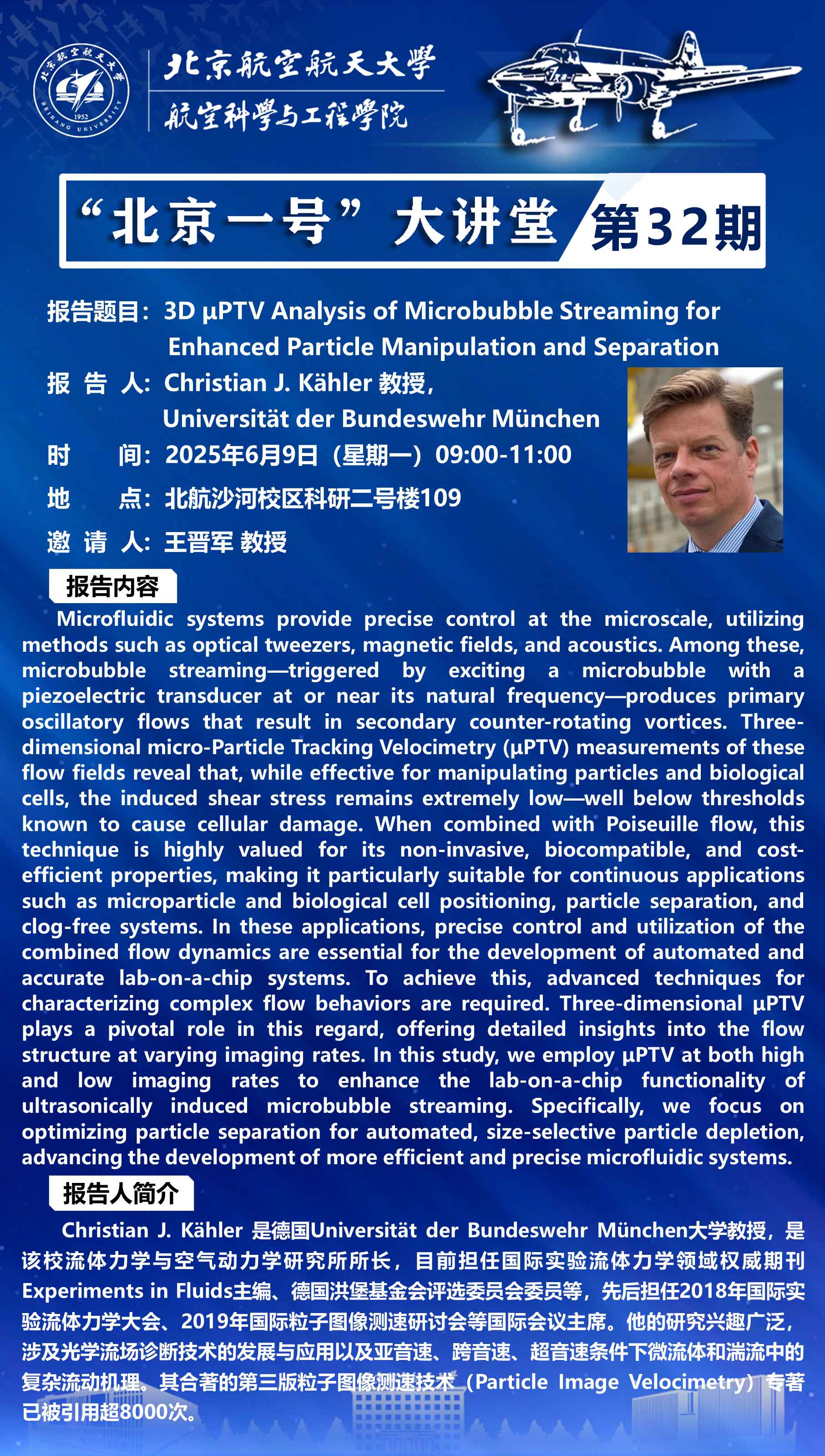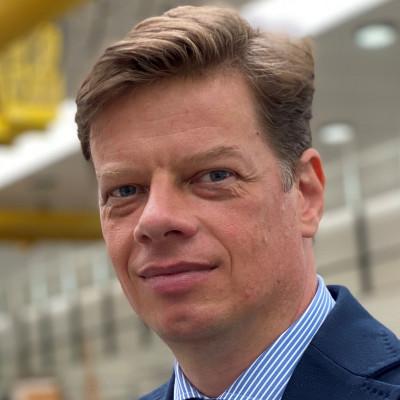


报 告 人:Christian J. Kähler, Universität der Bundeswehr München教授、Experiments in Fluids主编
报告题目:Lecture Series of Frontiers in Experimental Fluid Mechanics
Investigation of the Aerospike Nozzle Flow for Space Launcher Propulsion (1/3)
Analysis of Turbulent Flows by Simultaneous Fluorescent and Mie-Scattering PIV (2/3)
3D μPTV Analysis of Microbubble Streaming for Enhanced Particle Manipulation and Separation (3/3)
报告时间:
2025年6月5日(星期四)16:30-18:30
2025年6月6日(星期五)10:00-12:00
2025年6月9日(星期一)09:00-11:00
报告地点:北航沙河校区 科研2号楼109
主办单位:航空科学与工程学院
邀 请 人:王晋军 教授
报告内容:
本系列讲座将聚焦于亚音速、跨音速、超音速条件下微流体和湍流中的复杂流动机理实验研究。
第一讲:The plug/aerospike nozzle is a promising concept for use as a propulsion system for space launchers and space planes. The ability to adapt the nozzle jet to the ambient pressure level enhances thrust performance under overexpanded operating conditions compared to conventional bell nozzles. This feature is of great interest for future single-stage-to-orbit (SSTO) vehicles. This experimental research project investigates the topology and aerodynamics of a cold flow linear plug nozzle jet in an outer flow environment at the Trisonic Wind tunnel Munich (TWM). High-speed PIV and schlieren measurements are used to understand the mutual aerodynamic interaction between each other. The jet flow is studied for a variety of nozzle pressure ratios in combination with an outer flow at sub-, trans-, and supersonic Mach numbers. An examination of the flow is conducted for two plug lengths. It is noted that a truncated plug lowers the weight and reduces the risk of overheating in contrast to a long spike. In present studies, a newer wind tunnel model version is designed to study aerodynamic effects of a modular/clustered linear aerospike nozzle, while enabling thrust vector control strategies.
第二讲:While experiments in liquid media have long used flow tagging techniques such as dye injection to isolate parts of the flow, analogous methods that do not compromise full-field velocimetry in gas flows are highly impractical. The recent introduction of a solution of Pyrromethene 567 (P567) in Di-Ethyl-Hexyl-Sebacate (DEHS) to produce a seeding fluid capable of fluorescent emission in addition to Mie scattering promises to address this need. By locally seeding a secondary flow of interest with the modified DEHS, the fluorescent signal can be used for tagging; global seeding of main flow with standard DEHS, which only produces Mie scattering of incident laser light, is used to obtain full-field velocimetry with established PIV techniques. Performing morphological image processing and intensity-based thresholding on the fluorescent particle images yields a continuum representation of the secondary flow. This can then be combined with velocimetric information from PIV to conduct quantitative zonal analyses. This technique has been applied to the flow behind an active synthetic-jet turbulence grid and a turbulent boundary layer (TBL). With the new zonal decomposition capabilities offered, data relating to the intermittency of the flows, statistical structure of the phenomena, turbulent/non-turbulent interface (TNTI) and entrainment and detrainment can be extracted.
第三讲:Microfluidic systems provide precise control at the microscale, utilizing methods such as optical tweezers, magnetic fields, and acoustics. Among these, microbubble streaming—triggered by exciting a microbubble with a piezoelectric transducer at or near its natural frequency—produces primary oscillatory flows that result in secondary counter-rotating vortices. Three-dimensional micro-Particle Tracking Velocimetry (μPTV) measurements of these flow fields reveal that, while effective for manipulating particles and biological cells, the induced shear stress remains extremely low—well below thresholds known to cause cellular damage. When combined with Poiseuille flow, this technique is highly valued for its non-invasive, biocompatible, and cost-efficient properties, making it particularly suitable for continuous applications such as microparticle and biological cell positioning, particle separation, and clog-free systems. In these applications, precise control and utilization of the combined flow dynamics are essential for the development of automated and accurate lab-on-a-chip systems. To achieve this, advanced techniques for characterizing complex flow behaviors are required. Three-dimensional μPTV plays a pivotal role in this regard, offering detailed insights into the flow structure at varying imaging rates. In this study, we employ μPTV at both high and low imaging rates to enhance the lab-on-a-chip functionality of ultrasonically induced microbubble streaming. Specifically, we focus on optimizing particle separation for automated, size-selective particle depletion, advancing the development of more efficient and precise microfluidic systems.
报告人照片:

报告人简介:
Christian J. Kähle是德国Universität der Bundeswehr München大学教授,是该校流体力学与空气动力学研究所所长,目前担任国际实验流体力学领域权威期刊Experiments in Fluids主编、德国洪堡基金会评选委员会委员等,先后担任2018年国际实验流体力学大会、2019年国际粒子图像测速研讨会等国际会议主席。他的研究兴趣广泛,涉及光学流场诊断技术的发展与应用以及亚音速、跨音速、超音速条件下微流体和湍流中的复杂流动机理。其合著的第三版粒子图像测速技术(Particle Image Velocimetry)专著已被引用超8000次。
